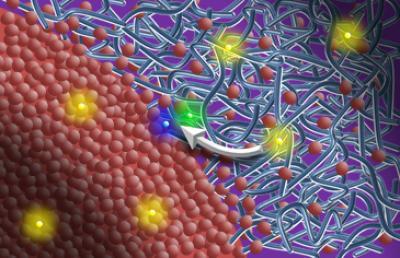Controlling "mixing" between acceptor and donor layers, or domains, in polymer-based solar cells could increase their efficiency, according to a team of researchers that included physicists from North Carolina State University. Their findings shed light on the inner workings of these solar cells, and could lead to further improvements in efficiency.
Polymer-based solar cells consist of two domains, known as the acceptor and the donor layers. Excitons, the energy particles created by solar cells, must be able to travel quickly to the interface of the donor and acceptor domains in order to be harnessed as an energy source. Researchers had believed that keeping the donor and acceptor layers as pure as possible was the best way to ensure that the excitons could travel unimpeded, so that solar cells could capture the maximum amount of energy.
NC State physicist Harald Ade and his group worked with teams of scientists from the United Kingdom, Australia and China to examine the physical structure and improve the production of polymer-based solar cells. In findings published in two separate papers appearing this month online in Advanced Energy Materials and Advanced Materials, the researchers show that some mixing of the two domains may not be a bad thing. In fact, if the morphology, or structure, of the mixed domains is small, the solar cell can still be quite efficient.

This is a molecular view at an interface between two regions in a solar cell. Red circles are buckyball fullerenes and are mixed with theblue spagetti-like polymer which work together to convert light intoelectricity.
(Photo Credit: Image by Brian Collins for Advanced Energy Materials. Copyright Wiley & Sons. Used with permission.)
According to Ade, "We had previously found that the domains in these solar cells weren't pure. So we looked at how additives affected the production of these cells. When you manufacture the cell, the relative rate of evaporation of the solvents and additives determines how the active layer forms and the donor and acceptor mix. Ideally, you want the solvent to evaporate slowly enough so that the materials have time to separate – otherwise the layers 'gum up' and lower the cell's efficiency. We utilized an additive that slowed evaporation. This controlled the mixing and domain size of the active layer, and the portions that mixed were small."
The efficiency of those mixed layers was excellent, leading to speculation that perhaps some mixing of the donor and acceptor isn't a problem, as long as the domains are small.
"We're looking for the perfect mix here, both in terms of the solvents and additives we might use in order to manufacture polymer-based solar cells, and in terms of the physical mixing of the domains and how that may affect efficiency," Ade says.
Source: North Carolina State University